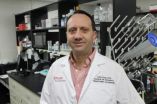(Press-News.org) The findings of a large international prospective study published in the Journal of Clinical Oncology suggest for the first time that women with BRCA1 mutations should have preventive ovarian surgery (prophylactic oophorectomy) by age 35, as waiting until a later age appears to increase the risk of ovarian cancer before or at the time of the preventive surgery. Women with a BRCA2 mutation, however, do not appear to be at an increased risk by age 35, suggesting they may delay this procedure until later. Moreover, women with BRCA1 and BRCA2 mutations who had this surgery experienced a 77 percent reduction in their overall risk of death by age 70.
Prior studies have shown that prophylactic oophorectomy reduces the risk of developing breast and ovarian cancers in women with BRCA1 or BRCA2 mutations; this is the first study to show an overall mortality reduction benefit. As many as 70 percent of women in the United States who learn they have BRCA mutations choose to have prophylactic oophorectomy. Many doctors recommend that such women undergo surgery by age 35 or when childbearing is complete. However, neither the optimum age for having this preventive surgery nor the effect of the surgery on the overall risk of death had been adequately studied.
"To me, waiting to have oophorectomy until after 35 is too much of a chance to take," said Steven Narod, MD, professor of medicine at the University of Toronto in Canada and the study's lead author. "These data are so striking that we believe prophylactic oophorectomy by age 35 should become a universal standard for women with BRCA1 mutations."
He added: "Women with BRCA2 mutations, on the other hand, can safely delay surgery until their 40s, since their ovarian cancer risk is not as strong."
In the Hereditary Ovarian Cancer Clinical Study, researchers from Canada, the United States, Poland, Norway, Austria, France, and Italy identified women with BRCA mutations from an international registry, 5,787 of whom completed questionnaires about their reproductive history, surgical history (including preventive oophorectomy and mastectomy), and hormone use. The study began in 1995, and the women were followed through 2011. Investigators examined the relationship between prophylactic oophorectomy and the rates of ovarian, fallopian tube, and primary peritoneal (abdominal) cancer, and the overall rate of death (total mortality) by age 70.
Among the 5,787 women, 2,274 did not have oophorectomy, 2,123 had already had the surgery when they began the study, and 1,390 underwent oophorectomy during the study follow-up period. After an average follow-up period of 5.6 years (with some women followed as long as 16 years), 186 women developed either ovarian, fallopian tube, or peritoneal cancer.
Overall, the investigators found that oophorectomy reduced the risk of ovarian cancer by 80 percent. For women who carry a BRCA1 mutation, the authors estimate that delaying the surgery until age 40 raised the risk of ovarian cancer to 4 percent; ovarian cancer risk increased to 14.2 percent if a woman waited until age 50 to have the surgery. In contrast, only one case of ovarian cancer was diagnosed before age 50 among BRCA2 mutation carriers in this study. By comparison, the lifetime risk of ovarian cancer in all women (including those without BRCA mutations) is only 1.4 percent.
Of the 511 women who died during this study, 333 died of breast cancer, 68 from ovarian, fallopian tube, or peritoneal cancers, and the remainder from other causes. Prophylactic oophorectomy reduced the risk of death by any cause by 77 percent (largely by lowering the risks of ovarian, fallopian tube, peritoneal, and breast cancers). Dr. Narod noted that the 77-percent risk decrease is even greater than the benefit of chemotherapy, and was equally strong for both BRCA1 and BRCA2 mutation carriers.
In a prior study by this group, oophorectomy was also shown to reduce the risk of breast cancer by 48 percent in women with a BRCA1 mutation, and once diagnosed, lowered the risk of breast cancer death by 70 percent.
ASCO Perspective
"These results could make a real difference for women with BRCA mutations, who face tough decisions about whether and when to undergo a prophylactic oophorectomy. For women with BRCA1 mutations, these results suggest that surgery should be performed as soon as it is practical," said Don Dizon, MD, ASCO Cancer Communications Committee member. "Importantly, for women who will be undergoing this surgery early in life, it's reassuring to see that it carries long-lasting benefits, substantially reducing ovarian cancer risk as well as total mortality risk."
INFORMATION:
Study shows preventive ovarian surgery in BRCA1 mutation carriers should be performed early
Substantial mortality risk reduction found for all BRCA mutation carriers
2014-02-24
ELSE PRESS RELEASES FROM THIS DATE:
JCI online ahead of print table of contents for Feb. 24, 2014
2014-02-24
Clinical trial assesses anti-FGF23 for treating X-linked hypophosphatemia
X-linked hypophosphatemia (XLH) is a heritable form of rickets that results from mutations in the gene encoding the phosphate regulating endopeptidase (PHEX). Unlike diet-associated forms of rickets, XLH cannot be ameliorated by vitamin D ingestion. XLH patients have increased serum levels of FGF23, which decreases both inorganic phosphate (Pi) and the activated form of vitamin D. In this issue of the Journal of Clinical Investigation, Thomas Carpenter and colleagues at Yale University evaluated ...
Seed dispersal gets a test in carved-out 'habitat corridors'
2014-02-24
MADISON, Wis. — Field ecologists go to great lengths to get data: radio collars and automatic video cameras are only two of their creative techniques for documenting the natural world. So when a group of ecologists set out to see how wind moves seeds through isolated patches of habitat carved into a longleaf pine plantation in South Carolina, they twisted colored yarn to create mock seeds that would drift with the wind much like native seeds.
The "seeds" were dusted with fluorescent powder and inserted into custom-made boxes mounted on poles, then released as the scientists ...
Better livestock diets to combat climate change and improve food security
2014-02-24
Livestock production is responsible for 12% of human-related greenhouse gas emissions, primarily coming from land use change and deforestation caused by expansion of agriculture, as well as methane released by the animals themselves, with a lesser amount coming from manure management and feed production.
“There is a lot of discussion about reduction of meat in the diets as a way to reduce emissions,” says IIASA researcher Petr Havlík, who led the study “But our results show that targeting the production side of agriculture is a much more efficient way to reduce greenhouse ...
Marine algae can sense the rainbow
2014-02-24
A new study published in Proceedings of the National Academy of Sciences has shown for the first time that several types of aquatic algae can detect orange, green and blue light.
Land plants have receptors to detect light on the red and far red of the spectrum, which are the common wavelengths in the air. These plants sense the light to move and grow as their environment changes, for example when another plant shades them from the sun. But in the ocean, the water absorbs red wavelengths, instead reflecting colours such as blue and green. As part of the study, a team of ...
A paper diagnostic for cancer
2014-02-24
CAMBRIDGE, MA -- Cancer rates in developing nations have climbed sharply in recent years, and now account for 70 percent of cancer mortality worldwide. Early detection has been proven to improve outcomes, but screening approaches such as mammograms and colonoscopy, used in the developed world, are too costly to be implemented in settings with little medical infrastructure.
To address this gap, MIT engineers have developed a simple, cheap, paper test that could improve diagnosis rates and help people get treated earlier. The diagnostic, which works much like a pregnancy ...
Species conservation poised to benefit from DNA advances
2014-02-24
A biologist at the University of York is part of an international team which has shown that advanced DNA sequencing technologies can be used to accurately measure the levels of inbreeding in wild animal populations.
The research by senior author Dr Kanchon Dasmahapatra, of the Department of Biology at York, and led by Dr Joseph Hoffman, of the Department of Animal Behaviour, Bielefeld University, Germany, may help efforts to conserve rare species.
Laboratory studies show that inbreeding reduces fitness. However, studying the impact of inbreeding in wild populations has ...
Acupuncture holds promise for treating inflammatory disease
2014-02-24
When acupuncture first became popular in the western hemisphere it had its doubters. It still does. But over time, through detailed observation, scientists have produced real evidence that ancient Chinese practitioners of the medical arts were onto something.
Now new research documents a direct connection between the use of acupuncture and physical processes that could alleviate sepsis, a condition that often develops in hospital intensive care units, springs from infection and inflammation, and takes an estimated 250,000 lives in the United States every year.
"Sepsis ...
New study shows a genetic link between feeding behavior and animal dispersal
2014-02-24
New research from the University of Toronto Scarborough shows that animal dispersal is influenced by a gene associated with feeding and food search behaviours.
The study, which was carried out by UTSC Professor Mark Fitzpatrick and PhD student Allan Edelsparre, provides one of the first aimed at gaining a functional understanding of how genes can influence dispersal tendencies in nature.
Using common fruit flies (Drosophila melanogaster), the researchers observed how two different foraging types – known as sitter flies and rover flies – moved over large distances ...
Ecotourism reduces poverty near protected parks, Georgia State University research shows
2014-02-24
ATLANTA--Protected natural areas in Costa Rica reduced poverty by 16 percent in neighboring communities, mainly by encouraging ecotourism, according to new research published today in the Proceedings of the National Academy of Sciences.
Although earlier studies indicated that establishing protected areas in poor regions can lead to reductions in poverty, there was no clear understanding why or how it happens.
"Our goal was to show exactly how environmental protection can reduce poverty in poorer nations rather than exacerbate it, as many people fear," says co-author ...
AGU: Uncovering the secret world of the Plastisphere
2014-02-24
HONOLULU – Scientists are revealing how microbes living on floating pieces of plastic marine debris affect the ocean ecosystem, and the potential harm they pose to invertebrates, humans and other animals. New research being presented here today delves deeper into the largely unexplored world of the "Plastisphere" – an ecological community of microbial organisms living on ocean plastic that was first discovered last year.
When scientists initially studied the Plastisphere, they found that at least 1,000 different types of microbes thrive on these tiny plastic islands, ...
LAST 30 PRESS RELEASES:
Injectable breast ‘implant’ offers alternative to traditional surgeries
Neuroscientists devise formulas to measure multilingualism
New prostate cancer trial seeks to reduce toxicity without sacrificing efficacy
Geometry shapes life
A CRISPR screen reveals many previously unrecognized genes required for brain development and a new neurodevelopmental disorder
Hot flush treatment has anti-breast cancer activity, study finds
Securing AI systems against growing cybersecurity threats
Longest observation of an active solar region
Why nail-biting, procrastination and other self-sabotaging behaviors are rooted in survival instincts
Regional variations in mechanical properties of porcine leptomeninges
Artificial empathy in therapy and healthcare: advancements in interpersonal interaction technologies
Why some brains switch gears more efficiently than others
UVA’s Jundong Li wins ICDM’S 2025 Tao Li Award for data mining, machine learning
UVA’s low-power, high-performance computer power player Mircea Stan earns National Academy of Inventors fellowship
Not playing by the rules: USU researcher explores filamentous algae dynamics in rivers
Do our body clocks influence our risk of dementia?
Anthropologists offer new evidence of bipedalism in long-debated fossil discovery
Safer receipt paper from wood
Dosage-sensitive genes suggest no whole-genome duplications in ancestral angiosperm
First ancient human herpesvirus genomes document their deep history with humans
Why Some Bacteria Survive Antibiotics and How to Stop Them - New study reveals that bacteria can survive antibiotic treatment through two fundamentally different “shutdown modes”
UCLA study links scar healing to dangerous placenta condition
CHANGE-seq-BE finds off-target changes in the genome from base editors
The Journal of Nuclear Medicine Ahead-of-Print Tip Sheet: January 2, 2026
Delayed or absent first dose of measles, mumps, and rubella vaccination
Trends in US preterm birth rates by household income and race and ethnicity
Study identifies potential biomarker linked to progression and brain inflammation in multiple sclerosis
Many mothers in Norway do not show up for postnatal check-ups
Researchers want to find out why quick clay is so unstable
Superradiant spins show teamwork at the quantum scale
[Press-News.org] Study shows preventive ovarian surgery in BRCA1 mutation carriers should be performed earlySubstantial mortality risk reduction found for all BRCA mutation carriers



